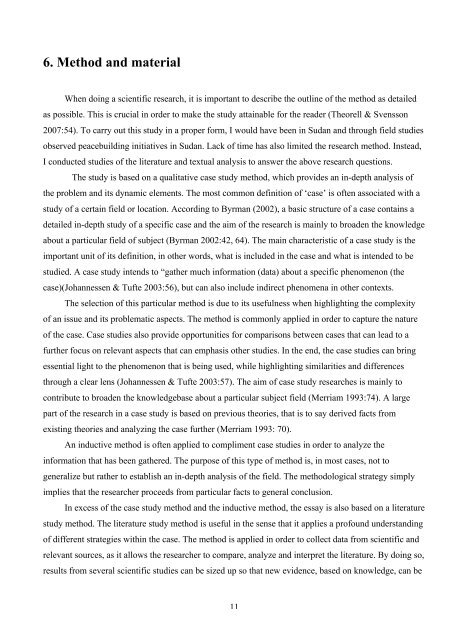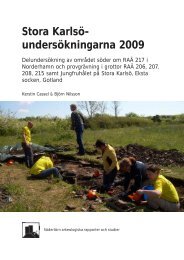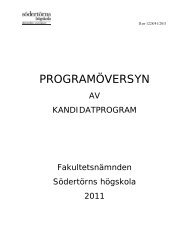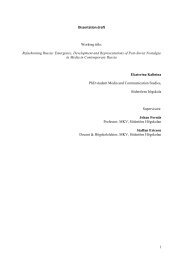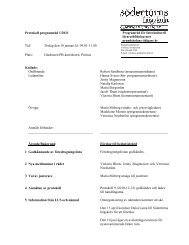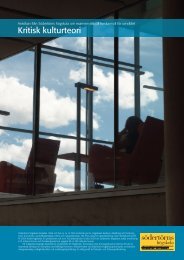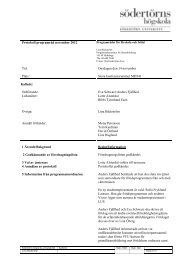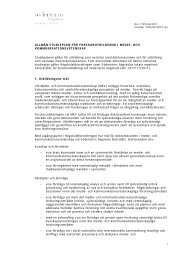CIVIL SOCIETY IN PEACEBUILDING - A Case Study Analysis of ...
CIVIL SOCIETY IN PEACEBUILDING - A Case Study Analysis of ...
CIVIL SOCIETY IN PEACEBUILDING - A Case Study Analysis of ...
Create successful ePaper yourself
Turn your PDF publications into a flip-book with our unique Google optimized e-Paper software.
6. Method and materialWhen doing a scientific research, it is important to describe the outline <strong>of</strong> the method as detailedas possible. This is crucial in order to make the study attainable for the reader (Theorell & Svensson2007:54). To carry out this study in a proper form, I would have been in Sudan and through field studiesobserved peacebuilding initiatives in Sudan. Lack <strong>of</strong> time has also limited the research method. Instead,I conducted studies <strong>of</strong> the literature and textual analysis to answer the above research questions.The study is based on a qualitative case study method, which provides an in-depth analysis <strong>of</strong>the problem and its dynamic elements. The most common definition <strong>of</strong> ‘case’ is <strong>of</strong>ten associated with astudy <strong>of</strong> a certain field or location. According to Byrman (2002), a basic structure <strong>of</strong> a case contains adetailed in-depth study <strong>of</strong> a specific case and the aim <strong>of</strong> the research is mainly to broaden the knowledgeabout a particular field <strong>of</strong> subject (Byrman 2002:42, 64). The main characteristic <strong>of</strong> a case study is theimportant unit <strong>of</strong> its definition, in other words, what is included in the case and what is intended to bestudied. A case study intends to “gather much information (data) about a specific phenomenon (thecase)(Johannessen & Tufte 2003:56), but can also include indirect phenomena in other contexts.The selection <strong>of</strong> this particular method is due to its usefulness when highlighting the complexity<strong>of</strong> an issue and its problematic aspects. The method is commonly applied in order to capture the nature<strong>of</strong> the case. <strong>Case</strong> studies also provide opportunities for comparisons between cases that can lead to afurther focus on relevant aspects that can emphasis other studies. In the end, the case studies can bringessential light to the phenomenon that is being used, while highlighting similarities and differencesthrough a clear lens (Johannessen & Tufte 2003:57). The aim <strong>of</strong> case study researches is mainly tocontribute to broaden the knowledgebase about a particular subject field (Merriam 1993:74). A largepart <strong>of</strong> the research in a case study is based on previous theories, that is to say derived facts fromexisting theories and analyzing the case further (Merriam 1993: 70).An inductive method is <strong>of</strong>ten applied to compliment case studies in order to analyze theinformation that has been gathered. The purpose <strong>of</strong> this type <strong>of</strong> method is, in most cases, not togeneralize but rather to establish an in-depth analysis <strong>of</strong> the field. The methodological strategy simplyimplies that the researcher proceeds from particular facts to general conclusion.In excess <strong>of</strong> the case study method and the inductive method, the essay is also based on a literaturestudy method. The literature study method is useful in the sense that it applies a pr<strong>of</strong>ound understanding<strong>of</strong> different strategies within the case. The method is applied in order to collect data from scientific andrelevant sources, as it allows the researcher to compare, analyze and interpret the literature. By doing so,results from several scientific studies can be sized up so that new evidence, based on knowledge, can be11


